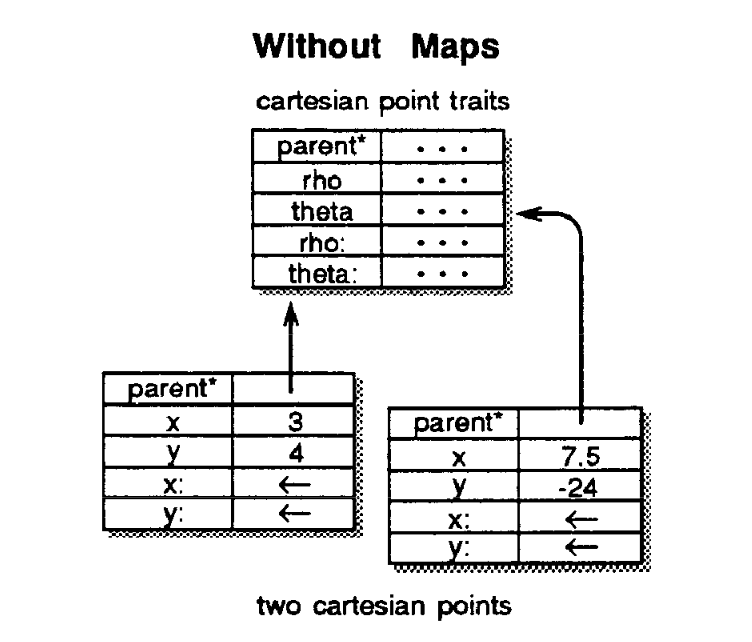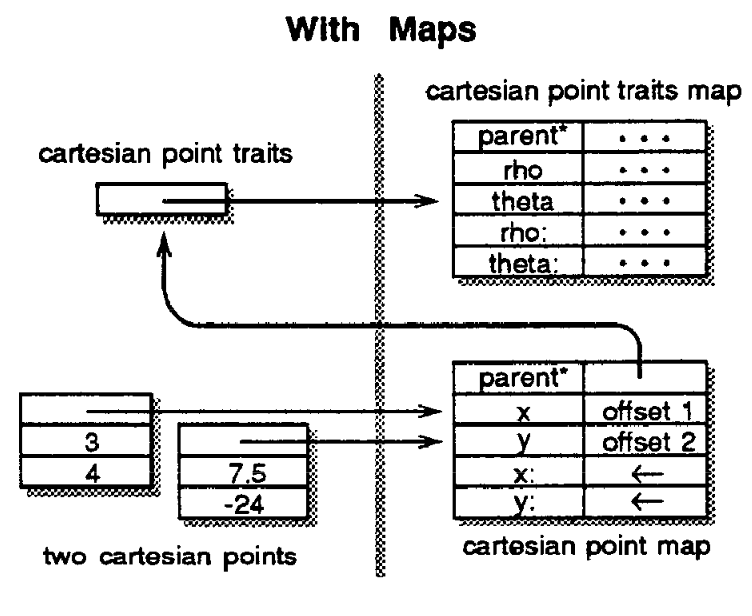An Efficient Implementation of Self
An Efficient Implementation of Self, a Dynamically-Typed Object-Oriented Language Based on Prototypes presents techniques for runtime compilation, now more commonly referred to as just-in-time (JIT) compilation, for the Self programming language.
We have developed and implemented techniques that double the performance of the dynamically-typed object oriented languages.
Due to the lack of a compiler name, I refer to the compiler presented in this paper as "the Self compiler".
The Challenge
The term "dynamic language" is mostly commonly associated with modern scripting languages like Python and JavaScript. Self, a much older language developed at the famed Xerox PARC labs, takes the philosophy of dynamism to a logical extreme -- everything in self is a message to an object. This includes Java-like method calls on object as well as control structures like loops and conditionals.1
Note: Self's multi-argument methods have the form:
( | IfTrue: trueBlock IfFalse: falseBlock = ( trueBlock value ). | )allowing for multiple named arguments. In Self parlance, the method name is read as
IfTrue:IfFalse:and is invoked by placing the arguments after each : separated name. See the Self documentation for more information.
For example, the Self condition IfTrue:IfFalse: is a method invocation on
the boolean object true and false. For an C-style conditional like the
following:
if (x) 1 else 2
the self invocation will look like:
x IfTrue: [ 1 ] IfFalse: [ 2 ]
The run-time behavior of this program is invoking the method IfTrue:IfFalse:
on the object x, which can be a true or false but is not required to be
those, and execute the "thunk" (a function with no argument) corresponding to
the true or the false branch. Note that x is not required to be true or
false. Any Self object can define the IfTrue:IfFalse: method and specify its
conditional behavior.
Considering this dynamism, a Self compiler must:
- Respect the semantics of method calls. Restricting or specializing conditionals and primitives don't follow the spirit of the language.
- Provide interactive speed. Recompiling after a small change is not an option because Self is meant for rapid exploration in a programming environment.
- Preserve stack traces. Self supports extreme reflection and introspection. A programming environment must be debuggable.
- Generate fast code. Interpreting the whole language is probably too slow.
The Solution
While the paper goes into the nitty-gritty of object layouts and method invocations, the essence of the paper can be summarized as:
When type information for an object is available, generate specialized code and let inlining and compiler optimizations work their magic.
The ideas in the paper have been widely adopted in modern JITs for dynamic languages like JavaScript (IonMonkey) as well as seemingly static languages like Java (HotSpot).
Object Layout
Self programs use object prototypes to describe inheritance relationships. Unlike classes, which have constructors used to build instances, Self uses prototypes, which act as exemplars for other objects. Creating a new object from a prototype is as simple as cloning it and setting its parent pointer to the prototype. Changing the common behavior of all clones is as simple as changing the behavior of a prototype. Since method and field lookups traverse the parent hierarchy, clones can also override methods and fields of their prototypes.
A naive layout scheme for objects would copy all fields from a prototype and end up wasting a lot of space describing potentially shared behaviors. The Self compiler minimizes space usage of clones derived from the same prototype by using clone families. Each cloned has an "allocation map" which stores its modifiable fields and has a pointer to its parent. The allocation map hierarchy mirrors the inheritance hierarchy in a program. If the instance ever overrides one of its parents' methods, the compiler creates a new clone family to preserve lookup semantics and propagate behavior changes to all clones of a prototype.


An allocation scheme without maps (left) and with maps (right). The scheme on right saves more memory.
Bytecode
The Self compiler and runtime come with a bytecode format for executing compiled
programs. Instead of executing a structured AST, the compiler defines a set of
core "instructions" for the runtime (more commonly known as a "Virtual Machine"
from Java parlance). Compared to a traditional ISA, the bytecode supports
high-level constructs like message SEND (invoke a method on a receiver).
It is worth noting that the description of the Self bytecode predates the Java
Virtual Machine (JVM) and directly inspired it.
Segregation & Tagging
Finding object references is one of the most common operations a runtime for an object oriented (OO) language has to perform. It is used for everything from garbage collection to reflection in modern OOP. The central challenge in finding objects is disambiguating pointers from integers since they look almost identical. A naive approach would be adding header information to pointers and parsing it at runtime. This incurs a runtime overhead of parsing headers and dramatically slowing down the runtime.
The Self compiler segregates the layout of byte arrays (which can confused as object references) and object references. Byte arrays are allocated from the top of the heap space while object references are allocated from bottom. The runtime can then completely skip objects beyond the object reference space boundary.
The Self compiler also tags integers and floating point numbers to disambiguate them from references. By default, two MSB bits are used to denote whether a machine word is an integer, a floating point number, a reference, or a header for an object. Integers and floating numbers are directly encoded into the remaining 30 bits, allowing them to be directly used after performing a single logical shift.
Customized Compilation
The rampant dynamism in Self programs forces compilers to conservatively
generate slow code. For example x < y is a method call on the object x and
requires knowing the precise type of x to generate optimized code for <.
The paper mentions that contemporary Smalltalk-80 compilers restricted the
customization of primitive methods and control structures to allow for
specialized code generation. Instead of imposing these restrictions, the Self
compiler will generate specialized code for every receiver object at runtime.
This means that at the first invocation of < on an integer, the compiler will
specialize < with check to see if the type matches to an integer and
generate a single compare instruction when this is case. When the type of
receiver has not been encountered before, Self will default to a method send
to the object.
Message Inlining and Splitting
Inlining remains one of the most crucial optimization in modern compilers, enabling other optimizations to become more effective. However, inlining becomes impossible in presence of dynamic method calls if the type of the receiver object is unknown. This is an even bigger problem for Self since most of program is a sequence of dynamic calls.
The Self compiler performs two optimizations, message inlining and splitting to enable efficient execution. Message inlining works in a similar fashion to customized compilation -- if the type of a receiver is known, either at initial compilation through a dataflow analysis or at runtime, inline the method body at the call location. When type information for an object is lost due to control flow splits, message splitting generates specialized code for possible receiver types and guards them using type tests. If the type of receiver matches, fast code can be executed.
For example, the following Self program
x > y
corresponds to the method invocation:
x["lessThan"](y)
which can be specialized as:
if (typeof(x) == 'integer' && typeof(y) == 'integer') {
Integer.lessThan(x, y) // Integer is the root object for all integers
}
else {
x["lessThan"](y)
}
and further inline the call to the root Integer object.
if (typeof(x) == 'integer' && typeof(y) == 'integer') {
cmp(x, y) // cmp is a single instruction
}
else {
x["lessThan"](y)
}
If the Self compiler can guarantee that x has the type integer, it can
inline the comparison and remove the guard.
Programming Environment Support
Unlike most modern languages, the Self language was designed to support tight integration and exploratory programming in and IDE. Programmers were expected and encouraged to inspect programs at runtime and dynamically modify the IDE itself while the program was executing to allow for better exploration.
This features require fast recompilation and debugging capabilities from any Self runtime and compiler. The compiler in the paper supports both incremental recompilation and source-level debugging by keeping track of the provenances of various method specializations in a map.
Incremental Recompilation occurs when the compiler observes a change in the programming environment and invalidates compiled methods associated with the affected data. At compile time, the compiler creates a dependency list encoding the information required for specialization. For example, if a method was inlined from a clone's parent, updating the parent pointer or the method body in the parent should invalidate the specialized code. Since the compiler selectively invalidates code, methods that weren't modified can still execute with specialized code.
Source-level Debugging requires language support and can often cause compiler writers to forgo obvious optimizations. For example, the Chrome V8 team decided to forgo tail call optimization due to due concerns about being unable to reconstruct stack frames. The programming environment needs to be able to step through specialized code as if it was going through the normal method call chain. Self appends debugging information to each compiled method, allowing the environment to reconstruct the state of the stack.
A SELFish Evaluation
The Self compiler was written in 33,000 lines of C++ code and ran on the Sun-3. The authors wrote 9,000 lines of Self code to implement the object hierarchy and prototype graphical user interface.
The quantitative evaluation compares Self running times to that of the fastest
Smalltalk-80 compiler at the time by translating the Stanford Integer
Benchmarks. The authors both did a straightforward transliteration of Self programs
(marked Self) and also rewrote the benchmarks in idiomatic Self (marked Self').

On average, Self was 2-3x faster than the Smalltalk implementation and 4x slower than the original C programs.
The authors also describes a new metric to measure the performance of an object oriented programming language -- Millions of Messages per Second (MiMS) which analogous to MIPS. To compute the MiMS of a specific virtual machine, divide the number of messages the benchmark sends by its total running time. The first generation Self compiler ran at 3.3 MiMS or a message executing every 300ns.
If this sounds suspiciously similar to JavaScript, it is because the design of JavaScript is directly inspired by Self.